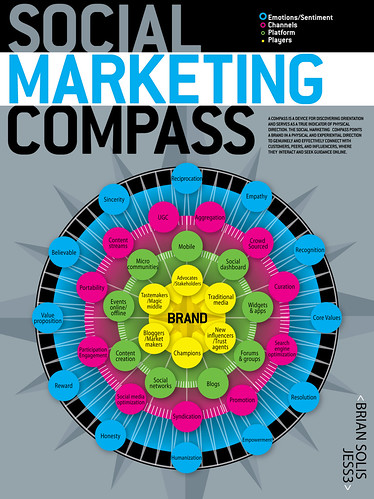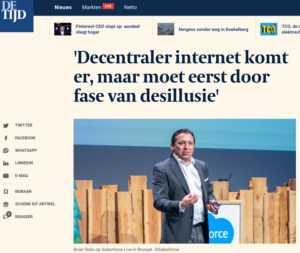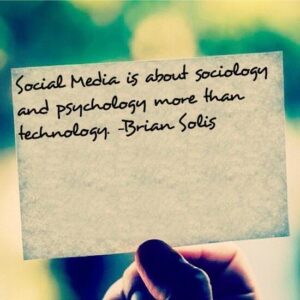Marcia W. DiStaso and Denise Sevick Bortree recently published a university-level textbook to address an important topic by the same name, The Ethical Practice of Social Media in Public Relations. As they were wrapping up the editing of the book, I was asked to contribute the foreword. Upon reading some of the manuscript, the answer was, YES! Of course, I asked if I could share it here with you and I’m happy to announce that it’s included below…
About The Ethical Practice of Social Media in Public Relations
Given the high rate of social media use by the public, organizations are compelled to engage with key audiences through these outlets. Social media engagement requires organizations to actively participate with public groups, and this highly-interactive exchange raises a new set of ethical concerns for communicators. In this rapidly changing communications environment, the long-term implications of social media are uncertain, and this book provides the much needed research to understand its impact on audiences and organizations.
Through an examination of a broad range of ethics concepts including transparency and online identities, policies, corporate responsibility, and measurement, this book explores a variety of topics important to public relations such as diversity, non-profit communication, health communication, financial communication, public affairs, entertainment communication, environmental communication, crisis communication, and non-profit communication. The chapter authors, expert scholars within their fields of public relations, offer insights drawn from original research and case study examples of ethical dilemmas raised by social media communication.
Foreword: Social Media is Lost without a Social Compass
Social media is not lawless. It is governed by the code of each network. At the same time however, each network is governed by the culture that develops in how people connect and communicate. The laws that we abide by in the real world influence what’s right and wrong. But more so, the laws of humanity govern what we say and do whereas judgment is passed according to the law of popular society and the unsaid ethics that serve its center.
Whether it’s right or wrong, what is right and wrong is open to interpretation. And, peers often pass judgment without the benefit of a fair trial.
Ethics therefore should not go unsaid or undefined.
Ethics symbolize the code that governs actions and unlocks relationships. The question is, what type of relationships do you want to build and have now and in the future?
Relationships?
Yes. They are the epicenter of social networks.
There’s a “social” in social media for a reason. There’s also a “me.”
At its very core, social media is not about technology, it’s about people. Connections, emotions, expression become the souls and personalities of online communities. The ties that bind them together are relationships. And it is in the value of relationships that people on either side will find value. Without value, mutual benefits, the quality of the relationship erodes.
Again I ask, what kind of relationship do you want to have with people?
Social media is a human and emotional egosystem (yes, that’s an intentional word). Networks are exchanges where conversations are currency. People connect because there’s value to do so.
So what is the value in a connection with you?
What do you get out of it?
What will I takeaway?
How do you want me to feel?
What do you want me to say and do?
So.Many.Questions.
It is in the answering of these questions that will govern all you do in social media.
Intentions + Actions = Perceptions
It’s a simple formula. What you aim to do combined with what you do shape the perceptions and resulting impressions and expressions of people directly and indirectly. Opinions and dialogue are commodities. In social media, expressions are not only shared, they are also sparks for greater discussions. With momentum, conversations can create communities and communities can inspire movements.
What you say and what people hear can in fact create two or more different outcomes.
The ethical practice of social media starts with an ethical foundation. Without it, you risk falling victim to social media’s relentless and unforgiving nature of real-time relevance or irrelevance. You are competing for the moment and for the future in all you do. Without a strong ethical foundation, you unintentionally make perilous decisions driven by what’s right…right now, rather than what’s truly right.
You Have Now Entered The Grey Zone
Martin Luther King Jr. did not say, “I have an ethical dream to share.” Walt Disney did not build a universe governed by morals. Instead, they challenged convention to change how we see the world. It was through their vision, words, architecture and leadership that visualized not only a new world, but they defined the roles we play in it and the advantages we’ll realize for doing so.
For better or for worse, ethics is not a black and white discussion. It’s often the grey-zone that sets the foundation for individual and organizational comfort zones. Much like in the legal world, what’s right and wrong is often open to interpretation. Laws represent a system of rules, which carry varying penalties if they’re broken. But it is in legal practice and the surrounding conversations within offices, conference rooms, and courtrooms that blur the line between meaning, understanding and outcomes. While precedence often dictates a center to explore opportunities and consequences, contending with legal matters after a rule or law is broken is not the premise of our work together.
We must address ethics now not in the face of challenges or troubles.
This is a time for leadership.
The Ethical Practice of Social Media is Where Actions and Words Speak Louder Than Silence
The promise of your work and how it will affect the work of others lies in an elixir of aspiration and ambition. Indeed, ethics are the moral principles that govern behavior. It’s in the intentions we have, the choices we make, the things we say, and the actions we carry out where we set the stage for reaction. But it’s the grey-zone where impressions and opinions are formed. And it is this judgment that becomes truth. As we all have learned, perception is reality. Ethics are therefore open to interpretation.
For every action, there is an equal and opposite reaction…
Plan.
Your work must be guided by aspiration, grounded in virtues and packaged in respect. Everything begins upon a clear ethical foundation. This means that like a vision or mission statement, your work must be governed by a manifesto that articulates hope, value, purpose, and expectations. It is guide where you, and anyone who sees is, will realize the promise and meaning of “why”—why you feel what you feel, do what you do, say what you say, and why anyone whom you touch should listen and more importantly, align with you. It’s your compass, your center, and your foundation.
Be Transparent. Be Authentic.
You’ll hear it throughout your practice of social media. Be transparent. Be authentic. These words however, are not the only points on your compass. They are however, important pillars that stand upon your ethical foundation. Without definition though, they’re just words.
Define them.
Transparency requires clarity. Authenticity requires honesty. Both are enlivened by definition and articulation in your manifesto and it is this manifesto that creates your social compass.
Your compass is more important than you may think.
A compass provides direction. It’s the Google Maps for doing what’s right for the moment for the good of the relationships you seek to invest in. It’s the GPS for navigating what is right and what is wrong before, during, and after engagement. Your compass will define the nature of relationships and influence what people see, hear and ultimately do as a result.
Your Social Compass
A compass is a device for discovering orientation and serves as a true indicator of physical direction.
In 2009, I designed a social compass to help guide the ethical and aspirational practice of social media. It debuted in my book Engage and was inspired by a moral compass. The Social Compass was created to serve as our value system when defining strategies, initiatives and ultimately engagement. It points a brand in a physical and experiential direction to genuinely and effectively connect with customers, peers, and influencers, where they interact and seek guidance online.
It was designed to guide us from the center outward. However, it can also impact how a business learns and adapts by reversing the process and listening to customers and influencers through each channel from the outside in.
When we listen and hear what’s taking place in the conversational egosystem, the compass works from the outside in, moving from the edge to the center. When we engage, we move from the center to the outside edge.
Center: The Brand
At the center of the compass is the brand; essentially, everything you do will revolve around it.
Halo 1: The Players
Fundamental to any program, the players define how, when, why, and to what extent our activity is intermediated across the Social Web. They include:
Advocates/stakeholders: Those individuals who maintain a stake in the brand and the success of the company, through emotional, strategic, or financial investment—and are usually among the first line of external champions.
Traditional media: Reporters, journalists, analysts, and other forms of mainstream and vertical media who already reach our intended audiences.
New influencers/trust agents: Individuals who focus a noteworthy portion of their updates, content, and voice on particular topics, industries, or markets.
Champions: Whereas advocates and stakeholders have skin in the game to some extent, champions are merely inspired to share their experiences and views because they are passionate, compelled, or incentivized.
Bloggers/market makers: Bloggers and market makers represent what some refer to as the “A-list.” This elite group can steer, shape, and galvanize activity that moves markets based on their views.
Tastemakers/Magic Middle: Tastemakers and the magic middle are distinct from new influencers and trust agents, and, depending on the industry, serve as a subset of them. In their own way they make markets and spark trends based on their activity. Tastemakers are the trendsetters and, in the Social Web, they usually boast notable followers and connections who emulate their behavior, whether it’s explicit or implicit, on behalf of the tastemaker. The term Magic Middle was coined by David Sifry, who at the time was CEO of Technorati, the world’s largest blog network; he defined this group as bloggers who maintained an inbound link volume of between 20 to 1,000 links.
I refer to the Magic Middle as any group of content creators who remain focused on a topic and have earned a substantial audience because of their experiences, views, and perspective.
Halo 2: Platform
Every initiative, inclusive of those groups of individuals who define our markets and ensuing behavior, requires a platform upon which to connect, communicate, and congregate. These platforms represent existing and also emerging categories that are worthy of our attention today and tomorrow:
Mobile: Any network that unites groups of targeted individuals through interaction on mobile devices.
Social dashboard/microsites: As discussed previously, social dashboards and microsites aggregate distributed social presences into one experience for channeling activity, providing information, fostering community, and guiding perception and impressions.
Widgets and applications: Widgets and applications are portable services that spark interaction in a variety of networks, from mobile devices to Web-based social networks. They create an immersive experience designed to perform a dedicated function including tasks, games, interaction, learning, and other forms of entertainment and engagement within a dedicated, embeddable environment, while branding or conveying messages in the process.
Forums and groups: Web 1.0 still rules, and through research we learn that communication and influence is still widespread in forums and groups where people not only communicate with each other every day, they also organize events, manage projects, and teach and learn from one another on almost every topic imaginable and unimaginable.
Blogs: Blogs, in all of their shapes and sizes, deserve a tremendous amount of attention, as they are still among the most active and influential news sources, besides traditional media. Not only do they hit mainstream audiences, they also focus on dedicated, vertical communities and nicheworks that equally contribute to your total market.
Social networks: Of course social networks are a primary forum for today’s social media interactions and therefore require a dedicated focus. As we’ve repeated so often in these pages, our attention is necessitated in popular networks as well as the nicheworks dedicated to our areas of interest.
Content creation: The development and syndication of social objects carries the ability to reach people in almost every medium today, and will only continue to expand as technology advances. We are now in the content publishing and distribution business.
Events (offline and online): The cultivation of communities is important online and also in the physical locales where we meet our customers, advocates, peers and influencers. A fusion between online and offline communication is critical and therefore mandatory.
Microcommunities: While many refer to these services as microblogs, the truth is that they are not in any way, shape, or form reminiscent of blogs, nor is the behavior that they stimulate. We focus on them as dedicated platforms due to their unique interactions, communities, efficacy, and reach.
Halo 3: Channels
Aggregation: The feeds, platforms, and devices that take content from multiple outlets or memes and funnel them into one branded stream
Crowdsourced: Organizing the activity of consumers onto public stages to foster dialogue, collaboration and glean insights
Curation: Designing social objects to appeal to social curators extending reach and visibility
SEO: If everything begins with search, SEO represents the enhancement of content, pages and destinations through search engine optimization to ensure brands are readily clickable upon relevant searches.
Promotion: Even the best content requires marketing. As social objects, campaigns, and engagement strategies are introduced, they must be complemented with genuine front and backchannel support. There is no such thing as viral marketing, but information travels to the extent of our connections and investment in them.
Syndication: Whereas aggregation is about many-to-one, syndication is about one-to-many. Please note that this does not refer to the mass broadcast of information to general audiences, syndication refers to the intentional repackaging of content for different platforms and nicheworks.
SMO: Similar to SEO, Social Media Optimization (SMO) amplifies the visibility of objects within social networks by improving their “findability” through tags, descriptions, titles, conversations, and linkbacks.
Participation/Engagement: Connections are much more than the 3F’s of friends, followers, and fans; they are fortified by the mutual value that is exchanged in each interaction. Engagement is measured by actions and outcomes.
Portability: Transmedia represents the ability to have stories and objects travel across multiple platforms and devices to match the behavior of the people we’re trying to reach. Portability must be defined to suit their needs.
Content Streams: Streams are the windows to relevance. People discover information through attention. Appearing in streams is how we compete for attention.
UGC: Often referred to as earned media, UGC is impressionable and can be steered positively. In addition, through active engagement combined with a recipe of all things above, reach and effect are increased through the genuine voices of others.
Halo 4: Emotions/Sentiment
The socialization of the Web is powered by people, and it is a movement that is bound by the same natural laws that govern human behavior. Successful branding is made possible when individuals can establish a human and emotional connection. In social networks, the brand is represented by you and, for that reason, we must factor compassion, care, and feeling into our planning. Connect from the heart.
Reciprocation: The gesture of a response is far more powerful than we perceive. It is the act of paying it forward that actually contributes to the caliber, quality, and value of dialogue and interchanges. As influence is both democratized and equalized, giving back is a symbol of respect and gratitude.
Empathy: Understanding the sentiment of another related to material interaction and experiences humanizes the context of an experience and conversation. You must become the very people you’re trying to reach and in order to do so, our understanding must extend beyond training and embrace real-life exposure.
Recognition: Identifying the contributions of others and promoting or responding to worthy individuals and instances are parts of how we cultivate communities and build relationships. From “thank you” to “I’m sorry,” the symbolic deeds of acknowledgment, admittance, and identification serve as powerful forms of validation.
Core values: The attributes that define the principles and standards of a brand are reinforced or diminished by its conduct. If we wish to attract influential peers, we must stand for something with which people can identify and associate. We must represent purpose. Our brand and our actions either encourage affinity or they don’t.
Resolution: The practice of solving problems, disputes, and other correlated issues is a focus and a mission that contribute to those actions that indeed speak louder than words. And, if we’re to be measured by them, then let our commitment to resolve impediments speak for itself.
Empowerment: Providing the authority to achieve something not possible before the encounter instills confidence and advocacy and sets the foundation to scale community development. Empowerment alters the balance of engagement and transforms interactions into relationships.
Humanization: Convey and embody a human voice and character in all we do in interactive media. From the creation and distribution of social objects to engagement with individuals, engagement is most effective when we personalize our approach. The Social Web is alive and powered by our ability to identify with others through direct interaction or by coming into contact with their personae, as attached to the content they interact with, share, or produce.
Honesty: Be honest and virtuous in all interactions and not misleading whatsoever in any scenario in order to achieve your objective. Be truthful. If you don’t have an answer or information, say so. If what you represent doesn’t measure up in a particular setting, admit it. Focus on strengths and opportunities. Do not spin or market messages.
Reward: Sometimes recognition isn’t enough to satisfy someone for their contribution. The act of rewarding someone is a sign of appreciation. Rewards can span from monetary items to discounts to free products to access and special privileges. The consistent performance of rewarding community behavior fosters increased activity through positive conditioning.
Value proposition: When humanizing our stories and interactions, it is the value proposition that speaks directly to specific markets. Many times marketing either attempts to generalize features or capabilities for the masses or simply reiterates the value propositions as dictated by internal management.
Believable: Words such as transparency and authenticity are overused in any discussion related to socialized outreach and therefore lose a good deal of their essence and meaning. It is more convincing and consequential in any encounter if you are believable. This can be passionate, exuberant, and contagious, unlike transparency or authenticity. Give me something to believe in.
Sincerity: Your biggest objective moving forward is to earn and continue to gain trust. In order to do so, your actions must exclude pretense and instead enrich interactions through the exchange of genuine feelings and intentions.
Define Your Path – Lead People on a Meaningful Journey
Social media is an emotional landscape and to succeed day in and day out takes more than communication, it takes vision and purpose. Without it, what do you stand for and why would anyone wish to stand alongside you?
As you design your social media strategies and everyday content and engagement programs, let your social compass guide you. Consider in simulation, and definitely prior to their activation in networks, how your intentions will convert to desired impressions. Doing so helps you understand how your actions will elicit the reactions you want. Use your social compass to then lead you into each network with confidence and relevance to earn relationships and spark meaningful engagement.
Remember, relationships aren’t just an outcome, they’re a reward for thoughtful, significant, and inspirational work.
Be strategic and thoughtful.
Be considerate.
Be empathetic.
Be approachable.
Ethics and the ethical practice of social media bridge the gaps between intentions and desired impressions and also between actions and desired reactions. You can only spark and enhance relationships as a result.
This is a time for leadership and you play a pivotal role in changing how your organization communicates and connects.
The ethical practice of social media is governed by your grey-zone. Defining what you do and what you will not do in various situations, guided by your vision in purpose, will answer what’s right, right now, and what’s right…for the future.
Give people a reason to do more than just connect or engage with you. Inspire them because you’re inspired.
Connect with me…
Twitter | LinkedIn | Facebook | Google+ |Youtube | Instagram | Pinterest
—-
To order the social compass poster, please email my colleague Ehsan with a request. He will follow up with instructions on how to purchase a 22 x 28 full color version.






![While AI learns and gets smarter and smarter, I spend my time preparing for the future by… [fill in the blank].
The most important skills of the future are human…
#creativity, #imagination, #individuality, #criticalthinking, #empathy
bit.ly/LifescaleBook 💫
Artist: @asiersanznieto
#promptengineering #prompting #ai #genai #artificialintelligence #keynotespeaker #motivationalspeaker #motivational #motivation #education #learning #leadership #leader](https://briansolis.com/wp-content/plugins/instagram-feed/img/placeholder.png)
This is a nice information. Thanks for sharing.
Thanks for this useful information